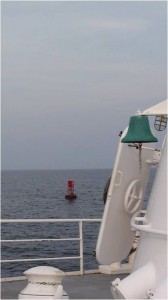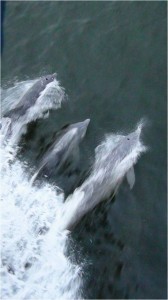The last line has been cast…
The last day has arrived. At the beginning of this cruise, we were looking at the calendar thinking what a long spans of time this would amount to. We were open to such an array of possibilities, so many new people to learn from and work with, the experience as a whole seemed overwhelming. Now, a short three weeks later, we are all gathering
for the last few hours packing and getting ready to disembark officially tomorrow.
Today was no lapse of activity though. We had two Landers to recover, samples to process, core tubes to archive, and an event unto itself, pack up the labs and supplies of 6 scientists. The Lander recoveries went like clockwork. All 18 samples were successfully collected from both, and are still being processed as we speak. Also during the last few stations, we were sampling pore water and sediments for Neodymium, a “rare Earth” element (called this even though it is widely distributed in the Earth’s crust), that Dr. McManus and April Abbott will be researching further in the years to come.
 Which brings me to the overview I would like to leave you with from this trip: science is not something to be only read, and it does not happen in a day. The efforts of 6 different scientists, plus the graduate students, research assistants, field assistants, and crew have been in the works for well over the past year to bring us to this point today. Grants were written and approved, preliminary research and logistics were carried out, and packing seems to be an art form, where they did not have the room to bring 15 extras of everything aboard but also did not run out of needed supplies. Now, that this portion is through, all of these samples, graphs, metadata, observations, and notes need to be processed and formulated into work that will be published; maybe questions will be answered, or maybe new questions will arise and need further study. This is the most basic way to put that more goes on behind the scenes to get to that point of publication, in which we the average citizens hear about research like this in a report or magazine article.
Which brings me to the overview I would like to leave you with from this trip: science is not something to be only read, and it does not happen in a day. The efforts of 6 different scientists, plus the graduate students, research assistants, field assistants, and crew have been in the works for well over the past year to bring us to this point today. Grants were written and approved, preliminary research and logistics were carried out, and packing seems to be an art form, where they did not have the room to bring 15 extras of everything aboard but also did not run out of needed supplies. Now, that this portion is through, all of these samples, graphs, metadata, observations, and notes need to be processed and formulated into work that will be published; maybe questions will be answered, or maybe new questions will arise and need further study. This is the most basic way to put that more goes on behind the scenes to get to that point of publication, in which we the average citizens hear about research like this in a report or magazine article.
And along the trip, no matter how busy, Dr. Berelson, Dr. Hammond, Dr. Maiti, Dr. McManus, Dr. Severmann, or Jesse Muratli would not only stop to explain what they were doing, but they would explore with us. We tried several variations on a redox experiment with the core samples. Unfortunately, the materials I was using did not work with the needs of the indicator to show lack of oxygen. However, Dr. Severmann took it upon herself to help me with distinguishing variables, ruling out possibilities of why it was not working, and was testing various hypotheses of her own along the way. Or Dr. Hammond would still take the time to sieve out some of his core samples, just to see what was in there. Science is constantly questioning and pursing answers…even if you are satisfied with the results of one series, you will still have questions that lead you to your next inquiry.
We want to thank all of you who have followed us on our journey, and hope you have learned a thing or two from this FerrOCious Cruise. There will be more lessons and elements posted in the next few weeks, as well as photos and videos from the expedition. Please continue to send us your questions as long as the link is available. Best wishes this coming year, and from all of the Science Team, Crew, and Teachers: Stay FerrOCious!
As it is posted on the board with our final daily schedule:
Aug 18
09:00 Lander I recovery
13:00 Lander II recovery
18:00 Kumalisa (Swahili for “completed”)


 August 19, 2011
August 19, 2011 











Recent Comments